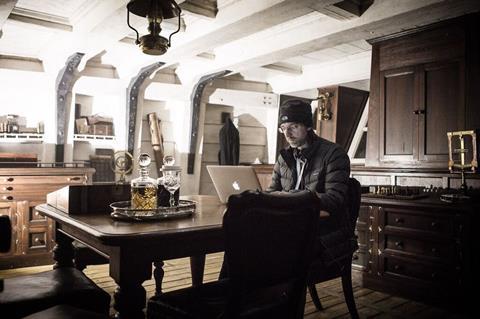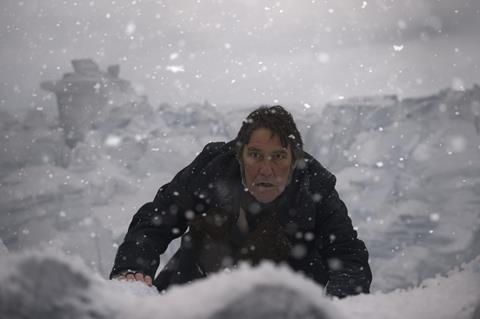David Kajganich has a prolific screenwriting career across multiple genres. His first outing as showrunner, on a series about a real British Navy expedition that went awry, posed a whole new set of challenges.

Self-confessed “film nerd” David Kajganich is best known as screenwriter of features like Oliver Hirschbiegel’s The Invasion, Luca Guadagnino’s A Bigger Splash and the upcoming remake of Suspiria, Guadagnino’s follow-up to his Oscar-nominated Call Me By Your Name.
No surprise, then that Kajganich is just as interested in character as genre, nor that for his first television project he found material, and a partner, with similar tendencies.
The material was The Terror, Dan Simmons’ 2007 novel that takes the true story of the British Royal Navy’s Franklin Expedition, which disappeared in the Arctic in 1845, and speculates that the expedition crew ended up battling not just cold, disease and starvation but a mysterious and ferocious creature as well.
The partner is Soo Hugh, creator of horror series The Whispers and a TV writer and producer with credits including Under The Dome and the US version of The Killing.
Kajganich and Hugh teamed up as executive producers and showrunners of the ten-episode limited series version of the novel, which, with Jared Harris, Ciaran Hinds and Tobias Menzies starring, debuts this week in the US on basic cable channel AMC and screens on either AMC networks or Amazon in other parts of the world.
The partnership worked, says Kajganich (also credited as series creator), because he and Hugh had the same priorities: “We wanted to make sure that genre, and the period setting, never stepped in front of character in the show. Whether you’re coming from features or television, some people are in that school and some people aren’t. We both are, even with different CV’s.
“I didn’t just need help with the learning curve of producing a television show,” Kajganich goes on. “This was a big, complicated project and it needed the combined vision of both of us to get the thing done.”
A shared dislike of conflict didn’t hurt either. “We’re not people who run on the fumes of chaos,” is how Hugh puts it.
Kajganich, who had been a professional wilderness guide before he turned to screenwriting, says that when he first heard Simmons, a revered name among horror and sci-fi fans, was tackling the story of the Franklin Expedition, “I understood the huge dramatic potential of crossing this disaster with horror, because you could use the horror allegorically.”
What’s more, he says, “the dramatic scenario was a pleasure to take on because it’s about people in a tight hierarchy who are being kept from connecting with one another because of rank, gender and class, and this disaster renders those things increasingly irrelevant.”
Read more: Cannes 2018 - who’s in the running?
Though he was beaten to acquiring rights to the novel by Universal, Kajganich was hired to do the script for a feature version. And he stayed involved through the years it took for the studio to drop the project and for AMC, looking to consolidate its horror reputation after the massive success of The Walking Dead, to pick it up (with Scott Free and EMJAG as the production entities).
On a budget that Hugh describes as “healthy, but nowhere near extravagant,” most of the series was shot against green screens in a Budapest studio, with some location work taking place on Pag, a barren island off the coast of Croatia.
The icy vistas against which the story unfolds – as well as the tale’s half-human, half-polar bear monster – were created digitally, demanding a total of around 2,000 VFX shots.
Kajganich (who himself wrote four episodes of the series) lived in Budapest for the duration of the shoot and both he and Hugh (who wrote two) worked closely with four other writers and the actors – who did their own research into historical documentation of the expedition - to rewrite dialogue and fine tune the scripts.
“We were always tweaking things,” Kajganich recalls, “not because there were issues but because there were opportunities to make things even tighter, more eerie, more psychologically revealing.”
The result is a piece of television that presents, its creator concedes, “a strange mix of genres. At points it’s a horror story, at points it’s a high adventure story. There are episodes that we wrote and cut like westerns. And it kind of has the feeling of a war film at times.”
The genre-bending is one aspect of The Terror that might not have been possible before the current boom in high-end drama production.
“I don’t think you could have made this show three years ago,” says Hugh, “just in terms of the technology and the budget. This show was made at a really great moment where the appetite is there, the talent pool is there - with more talent moving into television - and the VFX technology is there.”
Yet the show also arrives, Hugh suggests, “in the post-Game Of Thrones era, where everyone wants to create that epic world. Epic worlds take money and time, and I feel it’s just for bragging rights. We hope our audiences will say the show looks the way it should have looked. It didn’t look bigger than it needed to and it didn’t look smaller.”
For Kajganich, “a big part of the job early on was to convince our collaborators - our production designer, our costume designer, our VFX designer – that we really did want to step back from over-producing the show. It took us a while to convince people that we really wanted to pull back from the spectacle a little bit and give something richer in terms of character. There’s plenty of spectacle in the show, but it’s just not overdone.”

The Terror might also not have been possible but for the rise of the modern showrunner, that hard-to-define, American-invented hybrid of writer, producer, director and other roles besides.
“We’re standing on the shoulders of some great showrunners that have set the precedent,” says Hugh, citing the work of Matthew Weiner, David Chase and Shonda Rhimes. “Considering how serialised this show is and how many puzzle pieces there are to keep track of, you need that creative and producorial voice to stand at the top of the pyramid and keep an eye on the whole show.
“The feature model is director-driven. You can do that for two hours. It’s much harder to do that for ten hours.”
In a typical showrunner’s day, Hugh explains, “we write scripts, we’re there giving notes to the director, then we go to the editor’s room to edit the show, then we talk to marketing…”
“…and then,” Kajganich chimes in, “someone runs up with three different severed hands and wants you to pick the right one.”
“It’s a crazy job,” says the screenwriter of his first experience wearing a showrunner’s many different hats. “You have to have the answer for 7,000 things a day, some ridiculous, some sublime. You end up being the taste and conscience of the show. Because you want the show to feel like it’s the product of a unified voice.”

























No comments yet